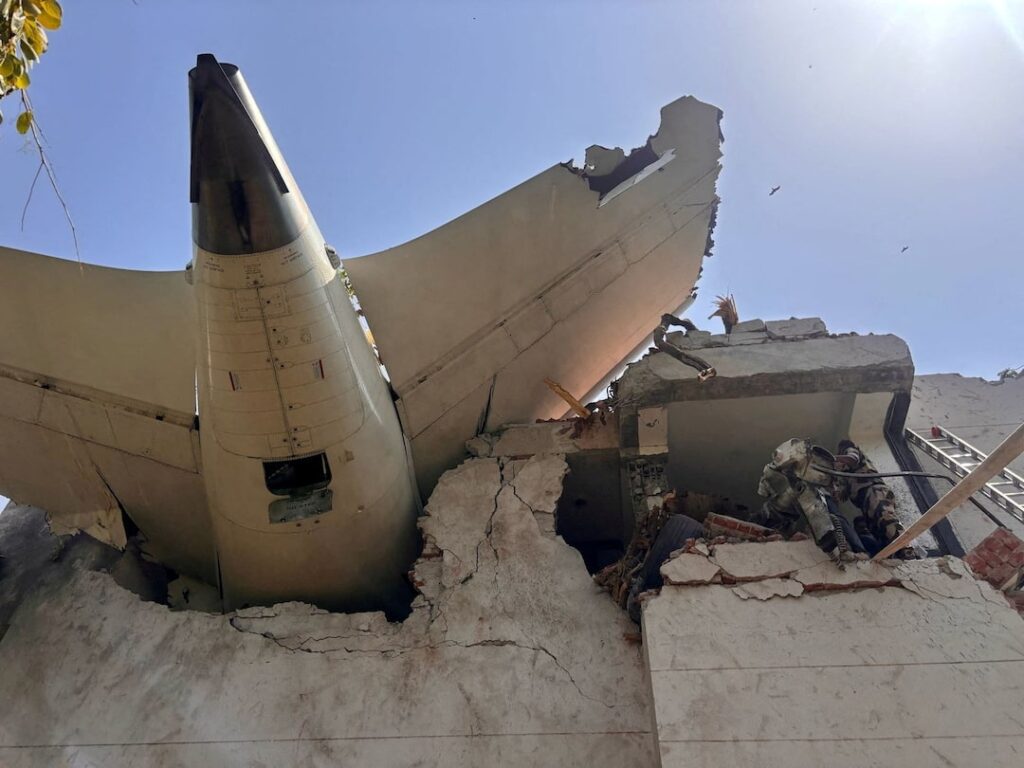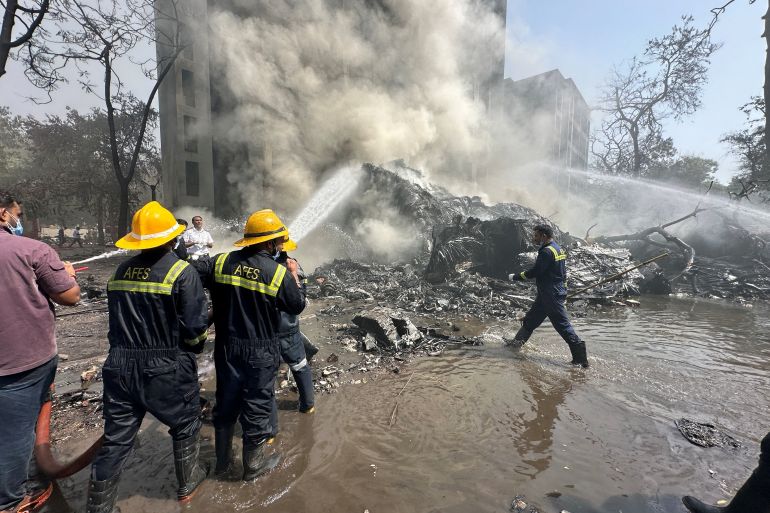A Comprehensive Study of India’s Worst Boeing 787 Disaster: The Crash of Air India Flight 171
Thirty seconds after taking off from Ahmedabad plane crash June 2025, Air India Flight 171, a Boeing 787-8 Dreamliner (tail VT-ANB), crashed. The plane, which was headed for London’s Gatwick Airport, lost altitude and struck the B.J. Medical College dorm building in the Meghani Nagar neighborhood, killing 241 people on board and 19 on the ground. There was only one survivor.

- Overview of the Crash and Immediate Repercussions
Around 13:39 IST, the aircraft carrying 242 passengers began to lose thrust and altitude during the ascent. Despite calling for help, the crew was unable to recover control. A student hostel was completely destroyed by the burning crash site, which caused major ground casualties and damage to the infrastructure en.wikipedia.org.
Military units and emergency personnel showed up on time. A British national who was the only survivor was saved and given medical attention in a hospital, according to news.sky.com. The government located each victim and gave their remains back to their distraught relatives.

- Black Box Retrieval & Preliminary Results hindustan times.
Within days, the flight data recorder (FDR) and cockpit voice recorder (CVR) were recovered by India’s Aircraft Accident Investigation Bureau (AAIB) with assistance from the National Transportation Safety Board (NTSB) of the United States. The gadgets were transported by air to Delhi under tight security to safeguard data integrity
. Analysis began promptly at a newly inaugurated lab in New Delhi, bolstered by state-of-the-art equipment installed just months prior.
Authorities described the aircraft and its GEnx engines as having a “clean history,” with the right engine replaced in March 2025 and the left undergoing overhaul in 2023
- Probable Causes & Ongoing Theories
Multiple hypotheses are under investigation:
a. Dual engine failure or fuel contamination
Video and audio captured both engines failing almost simultaneously, accompanied by emergency power generator activation—an abnormal event that typically signals total loss of engine power
the-independent.com+1youtube.com+1
.
b. Sabotage or deliberate sabotage
Authorities are examining potential tampering. Sabotage cannot be ruled out, and fuel contamination is being explored as part of this line of inquiry .
c. Takeoff configuration errors
Preliminary visuals suggest that flaps may have been improperly set and the landing gear was not fully retracted—highlighting possible crew or procedural errors .
d. Technical malfunction in onboard systems
Some passengers reported issues like malfunctioning air‑conditioning, cabin electronics, or “stuck” cabin call buttons on prior flights—raising fresh questions over maintenance quality
thesun.ie
.
Investigators are discounted bird strikes or external impacts. The AAIB, supported by ICAO guidelines, plans a preliminary report within 30 days, with a final report due in 12 months.
- Wider Safety Implications & Industry Response
a. Fleet grounding & inspections
Air India grounded some 787 and 777 aircraft to carry out enhanced safety inspections, rejigging schedules for medium-term review
news.sky.com+1economictimes.indiatimes.com+1
.
b. Investigative oversight
In order to maintain impartiality, India invited the International Civil Aviation Organization (ICAO) to serve as neutral observers but declined direct participation from UN-based investigators.
.
c. Regulatory scrutiny
The crash underscores gaps within the Directorate General of Civil Aviation (DGCA), criticized for vacancies and under-resourcing, despite rapid aviation market expansion
ft.com
. Ongoing incidents (e.g., AI 187 stall events hours later) have intensified pressure on regulators .
d. Boeing under scrutiny
This marks the first fatal crash involving a Boeing 787; Boeing is once again in the spotlight following recalls and investigations related to previous MAX-series disasters
washingtonpost.com
- Looking Ahead: Reforms & Recommendations
a. Strengthening oversight
DGCA will likely refocus resources on staffing, auditing, and compliance enforcement within Air India’s fleet operations.
b. Safety protocol enhancement
Expect greater scrutiny of crew training—especially emergency readiness and flap/gear procedures—and more rigorous pre-flight checks.
c. Infrastructure investment
The functional black-box lab in New Delhi is a welcome development—but Boeing’s black-box repair limitations may prompt international support or independent analysis
thescottishsun.co.uk
apnews.com+2ft.com+2abc7.com+2
.
d. Aircraft technology audit
Regulatory agencies may now mandate firmware updates or hardware checks for Boeing 787 GEnx engines and associated avionics.
Conclusion
While the Air India crash history is marked with sorrow and tragedy, it also stands as a testament to the lessons learned and reforms implemented in India’s civil aviation sector. From early mechanical failures to acts of terrorism, these incidents exposed vulnerabilities and paved the way for a safer, more robust aviation framework.
Today, Air India and Indian aviation authorities maintain rigorous safety standards, ensuring the skies remain safer for millions of passengers. Remembering these incidents honors those lost and serves as a reminder that continuous improvement in safety practices is vital in the aviation industry.
Stay updated with the latest news, exclusive images, and in-depth analysis of the tragic Ahmedabad Plane Crash June 2025. Visit our website for verified updates, eyewitness accounts, and investigation details in one place.
👉 katariatravels.site — Where facts meet urgency.
#AhmedabadPlaneCrash #June2025Crash #AirIndiaCrashUpdate #AviationNews #BreakingNewsIndia





